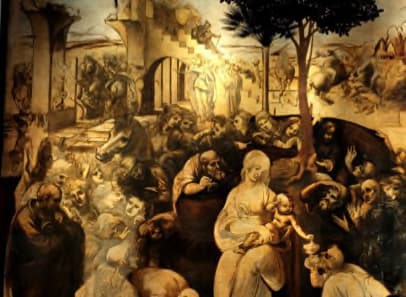Leonardo da Vinci’s Adoration of the Magi may contrast rather starkly with modern imagined settings of Nativity that are to be found on Christmas cards, but what it tries to depict has real theological seriousness. It attempts to describe, as only an artist can, the world into which Jesus was born. The old classical buildings are in a ruinous state. They represent past culture. In the distance cavalry men appear to fight out a war. The figures behind Mary look as if they’ve just crawled out of a zombie movie. The colours are sombre and foreboding. The only one of the Magi that it is possible to recognise as such hands the infant a container, most likely for myrrh, embalming fluid of the ancient world and symbol of death. Actually, this is not an attempt to imagine first century Palestine but to describe the role of Christ in Leonardo’s own day. It is his pictorial representation of The Waste Land in his own time.
Whilst Christmas cards and popular culture choose to depict Christmas as a happy time, Biblical accounts tell of a slaughter of innocent children, a power-hungry but insecure king in a precarious political situation. They speak of the urgent need of someone to save the world from what seems to many like its imminent and inevitable slide towards its demise. They are aware that, as the Magi in T. S. Eliot’s poem The Journey of the Magi, this event is as much about a death as about a life.
I look in vain to see any symbol of hope in this picture, and that is what separates it from the true Biblical tradition. Biblical accounts of joy, praise and thanksgiving are never ‘stand-alone’ events. They are subversive actions that refuse to let death and misery and suffering have the last word. Without the realistic appreciation of what I heard Kate Winslett recently describe on Desert Island Discs as ‘the brutality of life’, our joy and praise becomes nothing more than superficial, self-indulgent, happy-clappy denial. But when hope stands undefeated in the face of adversity, it is at its most powerful.
If we were to paint our own picture in this tradition, it would no doubt attempt to include war in Ukraine and elsewhere, poverty in the face of plenty, with pictures of food banks, perhaps. There might be bodies floating in the English Channel—the bodies of those fleeing persecution. It might well portray a gender-neutral Jesus to make a point. And all this against glowering skies symbolizing the climate change that so many, especially young, people believe presages the end of life on earth as we know it.
Of course, Christmas is but the prequel to the main story, but it points towards the theme of that main story, which is that hope is one of the things that abide and is an essential pre-requisite for living a human life to the full. Christians who truly live in hope will not allow themselves to be sucked into a whirlpool of despair. Their joy and praise will continue to be subversive, and they will continue to speak truth to power; whether it be the power of popular culture or power in a more obvious guise. They will continue to believe that God’s sending of his son is the ultimate sign that humankind is worth saving. Every generation could identify with Leonardo’s painting. It is for Christians to persuade the world to identify with what gives them hope.
John Holdsworth, Canon Theologian



